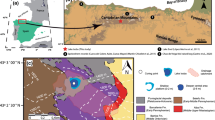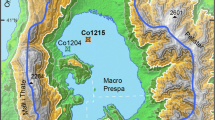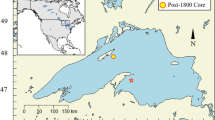Abstract
A general mean annual temperature increase accompanied with substantial glacial retreat has been noted on the Tibetan Plateau during the last two centuries but most significantly since the mid 1950s. These climate trends are particularly apparent on the southeastern Tibetan Plateau. However, the Tibetan Plateau (due to its heterogeneous mountain landscape) has very complex and spatially differing temperature and precipitations patterns. As a result, intensive palaeolimnological investigations are necessary to decipher these climatic patterns and to understand ecological responses to recent environmental change. Here we present palaeolimnological results from a 210Pb/137Cs-dated sediment core spanning approximately the last 200 years from a remote high-mountain lake (LC6 Lake, working name) on the southeastern Tibetan Plateau. Sediment profiles of diatoms, organic variables (TOC, C:N) and grain size were investigated. The 210Pb record suggests a period of rapid sedimentation, which might be linked to major tectonic events in the region ca. 1950. Furthermore, unusually high 210Pb supply rates over the last 50 years suggest that the lake has possibly been subjected to increasing precipitation rates, sediment focussing and/or increased spring thaw. The majority of diatom taxa encountered in the core are typical of slightly acidic to circumneutral, oligotrophic, electrolyte-poor lakes. Diatom species assemblages were rich, and dominated by Cyclotella sp., Achnanthes sp., Aulacoseira sp. and fragilarioid taxa. Diatom compositional change was minimal over the 200-year period (DCCA = 0.85 SD, p = 0.59); only a slightly more diverse but unstable diatom assemblage was recorded during the past 50 years. The results indicate that large-scale environmental changes recorded in the twentieth century (i.e. increased precipitation and temperatures) are likely having an affect on the LC6 Lake, but so far these impacts are more apparent on the lake geochemistry than on the diatom flora. Local and/or regional peculiarities, such as increasing precipitation and cloud cover, or localized climatic phenomena, such as negative climate feedbacks, might have offset the effects of increasing mean surface temperatures.





Similar content being viewed by others
References
An Z, Porter S, Kutzbach J, Xihao W, Suming W, Xiaodong L, Xiaoqiang L, Weijian Z (2000) Asynchronous Holocene optimum of the East Asian monsoon. Quat Sci Rev 19:743–762
Appleby PG (2001) Chronostratigraphic techniques in recent sediments. In: Last WM, Smol JP (eds) Tracking environmental change using lake sediments volume 1: basin analysis, coring, and chronological techniques. Kluwer Academic Publishers, Dordrecht
Appleby PG, Oldfield F (1978) The calculation of 210Pb dates assuming a constant rate of supply of unsupported 210Pb to the sediment. Catena 5:1–8
Battarbee R, Kneen M (1982) The use of electronically counted microspheres in absolute diatom analysis. Limnol Oceanogr 27:184–188
Battarbee RW, Jones VJ, Flower RJ, Cameron NG, Bennion H, Carvalho L, Juggins S (2001) Diatom analysis. In: Last WM, Smol JP (eds) Tracking Environmental change using lake sediments, vol. 3: terrestrial, algal and siliceous indicators. Kluwer Academic Publishers, Dordrecht
Böhner J (2006) General climatic controls and topoclimatic variations in Central and High Asia. Boreas 35:279–295
Bräuning A, Mantwill B (2004) Summer temperature and summer monsoon history on the Tibetan Plateau during the last 400 years recorded by tree rings. Geophys Res Lett 31:L24205
Camburn KE, Charles DF (2000) Diatoms of low-alkalinity lakes in the Northeastern United States. The Academy of natural Sciences, Philadelphia
Douglas MSV, Smol JP (2001) Freshwater diatoms as indicators of environmental changes in the High Arctic. In: Stoermer EF, Smol JP (eds) The diatoms: application for the environmental and earth sciences. Cambridge University Press, Cambridge, pp 227–244
Fan Z-X, Bräuning A, Tian Q-H, Yang B, Cao K-F (2010) Tree ring recorded May–August temperature variations since AD 1585 in the Gaoligong Mountains, southeastern Tibetan Plateau. Palaeogeogr Palaeocl Palaeoecol 296:94–102
Heck KL, van Belle G, Simberloff D (1975) Explicit calculation of the rarefaction diversity measurement and the determination of sufficient sample size. Ecology 56:1459–1461
Henderson A, Holmes J, Zhang J, Leng M, Carvalho L (2003) A carbon-and oxygen-isotope record of recent environmental change from Qinghai Lake, NE Tibetan Plateau. Chin Sci Bull 48:1463–1468
Herzschuh U, Kramer A, Mischke S, Zhang C (2009) Quantitative climate and vegetation trends since the late glacial on the northeastern Tibetan Plateau deduced from Koucha Lake pollen spectra. Quat Res 71:162–171
Holmgren SU, Bigler C, Ingólfsson Ó, Wolfe AP (2010) The Holocene–Anthropocene transition in lakes of western Spitsbergen, Svalbard (Norwegian High Arctic): climate change and nitrogen deposition. J Paleolimnol 43:393–412
Hou S, Chappellaz J, Jouzel J, Chu P, Masson-Delmotte V, Qin D, Raynaud D, Mayewski P, Lipenkov V, Kang S (2007) Summer temperature trend over the past two millennia using air content in Himalayan ice. Climate Past 3:89–95
Jones V, Birks H (2004) Lake-sediment records of recent environmental change on Svalbard: results of diatom analysis. J Paleolimnol 31:445–466
Koinig K, Kamenik C, Schmidt R, Agustí-Panareda A, Appleby P, Lami A, Prazakova M, Rose N, Schnell Ø, Tessadri R (2002) Environmental changes in an alpine lake (Gossenköllesee, Austria) over the last two centuries–the influence of air temperature on biological parameters. J Paleolimnol 28:147–160
Kramer A, Herzschuh U, Mischke S, Zhang C (2010) Holocene treeline shifts and monsoon variability in the Hengduan Mountains (southeastern Tibetan Plateau), implications from palynological investigations. Palaeogeogr Palaeoclimatol Palaeoecol 286:23–41
Krammer K, Lange-Bertalot H (1986–1991) Bacillariophyceae, vol. 1–4. Gustav Fischer Verlag, Stuttgart
Lami A, Turner S, Musazzi S, Gerli S, Guilizzoni P, Rose NL, Yang H, Wu G, Yang R (2010) Sedimentary evidence for recent increases in production in Tibetan Plateau lakes. Hydrobiologia 648:175–187
Lange-Bertalot H, Metzeltin D (1996) Indicators of Oligotrophy. In: Lange-Bertalot H (ed) Iconographia Diatomologica: annotated diatom micrographs, vol. 2. Koeltz Scientific Books, Königstein
Lepš J, Šmilauer P (2003) Multivariate analysis of ecological data using CANOCO. Cambridge University Press, Cambridge
Liang EY, Shao XM, Xu Y (2009) Tree-ring evidence of recent abnormal warming on the southeast Tibetan Plateau. Theor Appl Climatol 98:9–18
Liu X, Chen B (2000) Climatic warming in the Tibetan Plateau during recent decades. Int J Climatol 20:1729–1742
Liu Q, Wu Z, Hu D, Ye P, Jiang W, Wang Y, Zhang H (2004) SHRIMP U-Pb zircon dating on Nyainqentanglha granite in central Lhasa block. Chin Sci Bull 49:76–82
Lotter A, Bigler C (2000) Do diatoms in the Swiss Alps reflect the length of ice-cover? Aquat Sci 62:125–141
Lotter A, Pienitz R, Schmidt R (2001) Diatoms as indicators of environmental change near arctic and alpine treeline. In: Stoermer EF, Smol JP (eds) The diatoms: application for the environmental and earth sciences. Cambridge University Press, Cambridge, pp 205–226
Lotter A, Appleby P, Bindler R, Dearing J, Grytnes J, Hofmann W, Kamenik C, Lami A, Livingstone D, Ohlendorf C (2002) The sediment record of the past 200 years in a Swiss high-alpine lake: Hagelseewli (2339 m asl). J Paleolimnol 28:111–127
Meyers PA, Lallier-Vergès E (1999) Lacustrine sedimentary organic matter records of Late Quaternary paleoclimates. J Paleolimnol 21:345–372
Niu T, Chen L, Zhou Z (2004) The characteristics of climate change over the Tibetan Plateau in the last 40 years and the detection of climatic jumps. Adv Atmos Sci 21:193–203
Oksanen J, Kindt R, Legendre P, O’Hara B, Simpson GL, Solymos P, Stevens MHH, Wagner H (2008) Vegan: community ecology package. R package version 1.15-1
Pepin NC, Lundquist JD (2008) Temperature trends at high elevations: patterns across the globe. Geophys Res Lett 35:L14701
R Development Core Team (2008) R: a language and environment for statistical computing. R Foundation for Statistical Computing, Vienna, Austria
Renberg I (1990) A procedure for preparing large sets of diatom slides from sediment cores. J Paleolimnol 4:87–90
Rühland K, Smol J (2005) Diatom shifts as evidence for recent subarctic warming in a remote tundra lake, NWT, Canada. Palaeogeogr Palaeocl Palaeoecol 226:1–16
Rühland K, Priesnitz A, Smol J (2003) Paleolimnological evidence from diatoms for recent environmental changes in 50 lakes across Canadian Arctic treeline. Arct Antarct Alp Res 35:110–123
Rühland K, Phadtare N, Pant R, Sangode S, Smol J (2006) Accelerated melting of Himalayan snow and ice triggers pronounced changes in a valley peatland from northern India. Geophys Res Lett 33:L15709
Rühland K, Paterson A, Smol J (2008) Hemispheric-scale patterns of climate-related shifts in planktonic diatoms from North American and European lakes. Glob Change Biol 14:2740–2754
Smol J (1981) Problems associated with the use of``species diversity’’in paleolimnological studies. Quat Res 15:209–212
Smol J, Wolfe A, Birks H, Douglas M, Jones V, Korhola A, Pienitz R, Ruhland K, Sorvari S, Antoniades D (2005) Climate-driven regime shifts in the biological communities of arctic lakes. P Natl Acad Sci 102:4397–4402
Solovieva N, Jones VJ, Nazarova L, Brooks SJ, Birks HJB, Grytnes JA, Appleby PG, Kauppila T, Kondratenok B, Renberg I (2005) Palaeolimnological evidence for recent climatic change in lakes from the northern Urals, arctic Russia. J Paleolimnol 33:463–482
Sorvari S, Korhola A, Thompson R (2002) Lake diatom response to recent Arctic warming in Finnish Lapland. Glob Change Biol 8:171–181
Su Z, Shi Y (2002) Response of monsoonal temperate glaciers to global warming since the Little Ice Age. Quatern Int 97–98:123–131
Ter Braak CJF, Šmilauer P (2002) CANOCO reference manual and CANODRAW for windows user’s guide: software for canonical community ordination (Version 4.5). Microcomputer Power, New York
Ter Braak CJF, Verdonschot PFM (1995) Canonical correspondence analysis and related multivariate methods in aquatic ecology. Aquat Sci 57:255
Thompson LG, Mosley-Thompson E, Davis ME, Bolzan J, Dai J, Klein L, Yao T, Wu X, Xie Z, Gundestrup N (1989) Holocene-Late Pleistocene climatic ice core records from Qinghai-Tibetan Plateau. Science 246:474
Thompson L, Yao T, Mosley-Thompson E, Davis M, Henderson K, Lin P (2000) A high-resolution millennial record of the South Asian Monsoon from Himalayan ice cores. Science 289:1916–1919
Thompson LG, Yao T, Davis ME, Mosley-Thompson E, Mashiotta TA, Lin PN, Mikhalenko VN, Zagorodnov VS (2006) Holocene climate variability archived in the Puruogangri ice cap on the central Tibetan Plateau. Ann Glaciol 43:61–67
Tucker ME (1988) Techniques in sedimentology. Blackwell Scientific Publications, Oxford
USGS earthquakes (2010) http://earthquake.usgs.gov/earthquakes/world/events/1950_08_15.php. Access on 16 Feb 2010
USGS earth explorer (2010) http://edcsns17.cr.usgs.gov/EarthExplorer/. Access on 14 April 2010
Wrozyna C, Frenzel P, Steeb P, Zhu L, Geldern Rv, Mackensen A, Schwalb A (2010) Stable isotope and ostracode species assemblage evidence for lake level changes of Nam Co, southern Tibet, during the past 600 years. Quatern Int 212:2–13
Wu Q, Zhang T (2008) Recent permafrost warming on the Qinghai-Tibetan Plateau. J Geophys Res 113:D13108
Yang X, Sumin W, Kamenik C, Schmidt R, Shen J, Liping Z, Shengfeng L (2004) Diatom assemblages and quantitative reconstruction for paleosalinity from a sediment core of Chencuo Lake, southern Tibet. Sci China Ser D 47:522–528
Yang M, Yao T, Wang H, Gou X (2006) Correlation between precipitation and temperature variations in the past 300 years recorded in Guliya ice core, China. Ann Glaciol 43:137
You Q, Kang S, Wu Y, Yan Y (2007) Climate change over the Yarlung Zangbo River Basin during 1961–2005. J Geogr Sci 17:409–420
You Q, Kang S, Pepin N, Flügel W-A, Yan Y, Behrawan H, Huang J (2010) Relationship between temperature trend magnitude, elevation and mean temperature in the Tibetan Plateau from homogenized surface stations and reanalysis data. Global Planet Change 71:124–133
Zhang Y, Li T, Wang B (2004) Decadal change of the spring snow depth over the Tibetan Plateau: the associated circulation and influence on the East Asian summer monsoon. J Climate 17:2780–2793
Zhu H, Chen J (2000) Bacillariophyta of the Xizang Plateau. Science Press, Beijing in Chinese
Acknowledgments
We would like to thank Chengjun Zhang (Lanzhou University) for his help during fieldwork; Vivienne Jones and Carl Sayer for helpful advice with diatom identification; and Ute Bastian for her support in the sediment lab. Comments and advice from Kathleen Rühland and one anonymous reviewer are greatly appreciated. This research was funded by a scholarship to J. W. as part of the German Research Council (DFG, Deutsche Forschungsgemeinschaft) graduate school GRK1364.
Author information
Authors and Affiliations
Corresponding author
Electronic supplementary material
Below is the link to the electronic supplementary material.
10933_2011_9533_MOESM1_ESM.docx
Table 1 Species list with authorities, Synonyms, and abbreviations. Asterisk indicates taxa with maximum relative abundance of <1%. (DOCX 42 kb)
Rights and permissions
About this article
Cite this article
Wischnewski, J., Mackay, A.W., Appleby, P.G. et al. Modest diatom responses to regional warming on the southeast Tibetan Plateau during the last two centuries. J Paleolimnol 46, 215–227 (2011). https://doi.org/10.1007/s10933-011-9533-x
Received:
Accepted:
Published:
Issue Date:
DOI: https://doi.org/10.1007/s10933-011-9533-x




